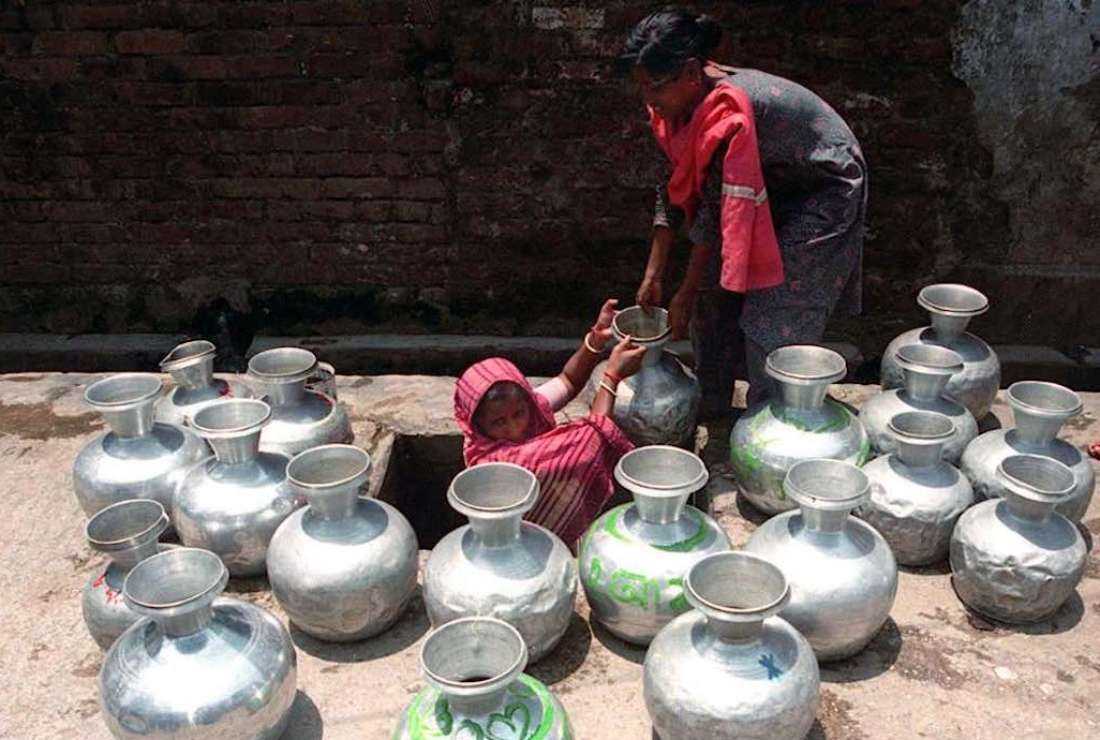
A Catholic church helps villagers with fresh water but over-exploitation is causing the water table to decline further

Thirty-two-year-old homemaker, Kalpana Hembrom, begins her day by walking with a clay pitcher to a freshwater source, one kilometer away.
With the pitcher on her head, she walks back to repeat the same chore four times a day. Each day, she walks eight kilometers to fetch 50 liters of drinking water.
Her routine is no different from some 250,000 people in the drought-prone Barind tract of the Rajshahi region in northern Bangladesh where groundwater levels have dropped drastically, affecting agriculture and daily activities.
The Barind tract, a generally warm and humid area, covers most parts of Dinajpur, Rangpur, Pabna, Rajshahi, Bogra, Joypurhat and Naogaon districts in northern Bangladesh.
Local authorities in Hembrom's Mahalipar village, which comes under Mundumala Municipality, have attempted to dig boreholes up to 200 meters deep but could not find water.
She said some 12 years ago their tube wells ran dry and then they used to collect water from nearby houses that had underground water pumps. However, those water pumps have also dried up in recent years, worsening the water situation.
“We now walk one kilometer to fetch water. If water is still not available there, we have to travel further to purchase it. But, buying water is unaffordable,” she said.
Mahali tribal people, like her, engage in bamboo-cane work and make a maximum of 300 taka (US$2.80) per day, which is not enough to buy water.
"We have to pay 25 taka for 1 liter of water," she said.
The water crisis has also led to health issues.
“Many women in our village are experiencing urinary tract infections and skin diseases due to bathing in muddy ponds,” she said.
Chichilia Hasda, 48, a housewife in Mahalipar village, said her family of seven needs six pitchers of water for cooking and drinking each day.
"In the morning and afternoon, my two daughters and I fetch water. We always have to be very frugal about water usage and drink less.”
“Bathing is also a challenge. We have a pond in front of our house, but it doesn't have much water. Unfortunately, the pond water sometimes leads to diarrhea. Cows also fell sick after drinking from it," Hasda added.
Earlier they faced water scarcity only during summer, but it is felt throughout the year now. The shortage has also affected agriculture. Cultivation is only possible during the rainy season.
Joachim Hembrum, 62, a Mahalipar farmer and day laborer, said despite extensive efforts to dig boreholes, water remains unavailable in his area.
"Previously, we used to receive water from the municipality, but even that source has dried up. Throughout the year, we face water scarcity.”
The local Mundumala Catholic Church distributes water twice a day to people, irrespective of caste and religion, for a nominal fee of 10 taka per day.
“For the past two months, we have been supplying water to some 45 families in the village," said Father Bernard Tudu from the Catholic church in Mundumala.
The priest said they have installed a new submersible water pump and informed the village leaders that they can get water from the church until the municipality restores the supply.
In 1985, the Barind Multipurpose Development Authority (BMDA) began installing deep tube wells in the region. It has installed some 15,100, but the project was halted in 2012 as water levels continuously declined.
“The water problem in the Barind area is influenced by its geographical location, climate change, reduced rainfall, and inadequate river water supply," says Jahangir Alam, the BMDA's additional chief engineer.
He said to address the issue several measures have been taken. This includes the construction of 3,863 ponds, 2,262 kilometers of canals, and a dam across the Barnai River.
“As a result of the dam, approximately 6,500 hectares of agricultural land along the river has been brought under irrigation.”
Additionally, farmers are encouraged to cultivate crops that require less irrigation, such as wheat, maize, potato, cotton, and mango orchards, Alam added.
Out of the 13 major rivers in the Rajshahi division, 11 have completely dried up, he said.
Experts like Shafiqul Islam Sheikh, an executive engineer of the Rajshahi Water Development Board, said during the dry season the water level of the region's main Padma River drops below the bed levels of other rivers in the region. Other rivers, for whom Padma serves as the main water source, then dry up.
“River dredging projects are being undertaken to increase the water-holding capacity of the Padma River during the rainy season," but that effort has not been successful, he said
Padma, which flows from India to Bangladesh, is one of four major rivers in Bangladesh.
However, Professor Chowdhury Sarwar Jahan of the Geology and Mining Department of Rajshahi University, says a major problem is the lack of a water storage system.
Other than collecting water in ponds, the country has no system to conserve water on the surface. "Therefore, farmers have to depend on groundwater for agriculture and living,” he said.
“The Barind area is a drought-prone area. When the groundwater level goes down, the moisture content of the surface soil also decreases, resulting in increased drought proneness. The region has also seen more heat waves last year and this year than before.”
He also said that the groundwater level in the Barind region is falling by 30 centimeters (12 inches) every year due to excessive use of groundwater.
“It is crucial to implement integrated water management in the Barind region by focusing on key objectives. These include conserving rainwater, reducing reliance on groundwater, and promoting water-efficient agricultural practices," Jahan said.
A sustainable, long-term program should be implemented, "backed by thorough research, to ensure the region's water resources are managed effectively and in a sustainable fashion," Jahan added.
Until that happens, Hembrom will continue to carry water in her clay pitcher, walking eight kilometers a day.
Help us keep UCA News independent
The Church in Asia needs objective and independent journalism to speak the truth about the Church and the state.
With a network of professionally qualified journalists and editors across Asia, UCA News is just about meeting that need. But professionalism does not come cheap. We depend on you, our readers, to help maintain our independence and seek that truth.
A small donation of US$2 a month would make a big difference in our quest to achieve our goal.

Share your comments